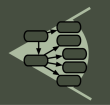| Line 34 was replaced by line 34 |
| - Are there ways to "add" domain-specific extension ontologies to the core? |
| + Are there ways to "add" domain-specific extension to the core definition of an "observation"? |
| Lines 38-39 were replaced by line 38 |
| - clarify subsumption (more/less general) and other (part_of, constituted_of) relationships among terms |
| - necessary "components" of an observation; necessary & sufficient? |
| + And aside from synonymies, also clarify subsumption (more/less general) and other (part_of, constituted_of) relationships among terms in the various models? Can we identify necessary "components" of the various models for observation (e.g., are space and time information explicitly necessary?); necessary & sufficient (is it sufficient to simply have some measured value of some property of an entity? |
| Line 41 was replaced by line 40 |
| - 3) Need unambiguous definitions of Keywords* (currently massive overloading) |
| + 3) Need unambiguous definitions of Keywords* (currently massive overloading on many of those listed below...) |
| Lines 59-61 were replaced by lines 58-60 |
| - 4) Is the assertion of some specific entity type (rock, crow) best accomplished as a special form of measurement (attribute=NAME) |
| - Identifying vs non-identifying names |
| - presence/absence measurements-- are these (ontologically) different from say, measuring mass of a specimen? |
| + 4) Is modeling the assertion of some specific ("named") entity type (e.g., rock, crow) best considered as a special form of measurement (attribute type=NAME) |
| + Identifying vs non-identifying names (e.g., Corvus corax vs "Plot A") |
| + presence/absence measurements-- do these need to be treated (ontologically) different from say, measuring mass of a specimen? |
| Line 63 was replaced by line 62 |
| - counts (is a property of set of individuals)-- does this create problems with the model? |
| + counts (is a property of set of individuals)-- how does observation model accomodate this type of measurement? |
| Line 66 was replaced by line 65 |
| - 5) Do "where" and "when" pertain globally and consistently to any type of observation of interest, or are these also types of observation |
| + 5) Do "where" and "when" information pertain globally and consistently to any type of observation of interest, or are these also types of observations that can provide context for other observations? |
| Line 68 was replaced by line 67 |
| - 6) Is there ability within the Observation model, to inter-relate observations to "construct" composite or emergent entities, processes or phenomena? |
| + 6) Is there ability within the Observation model, to inter-relate observations to "construct" composite and emergent entities, processes or phenomena? |
| Line 70 was replaced by line 69 |
| - 7) How can ontology/model be applied? Must data be ingested into framework implementing the model, or can model(s) be applied to data (e.g., via annotation) |
| + 7) How can ontology/model be deployed in terms of real useful applications? Must data be ingested into a framework implementing the model, or can the model(s) be applied to data (e.g., via annotation) |








